This post may contain affiliate links. See my disclosure policy.
This unbelievably delicious Vietnamese Pho Recipe is made with a nourishing beef broth infused with fragrant spices, chewy noodles, and tender slices of meat. Filled with the same delicious and authentic flavors as your favorite pho restaurant, learn how to make this Vietnamese Noodle Soup from scratch and serve topped with fresh herbs and vegetables.
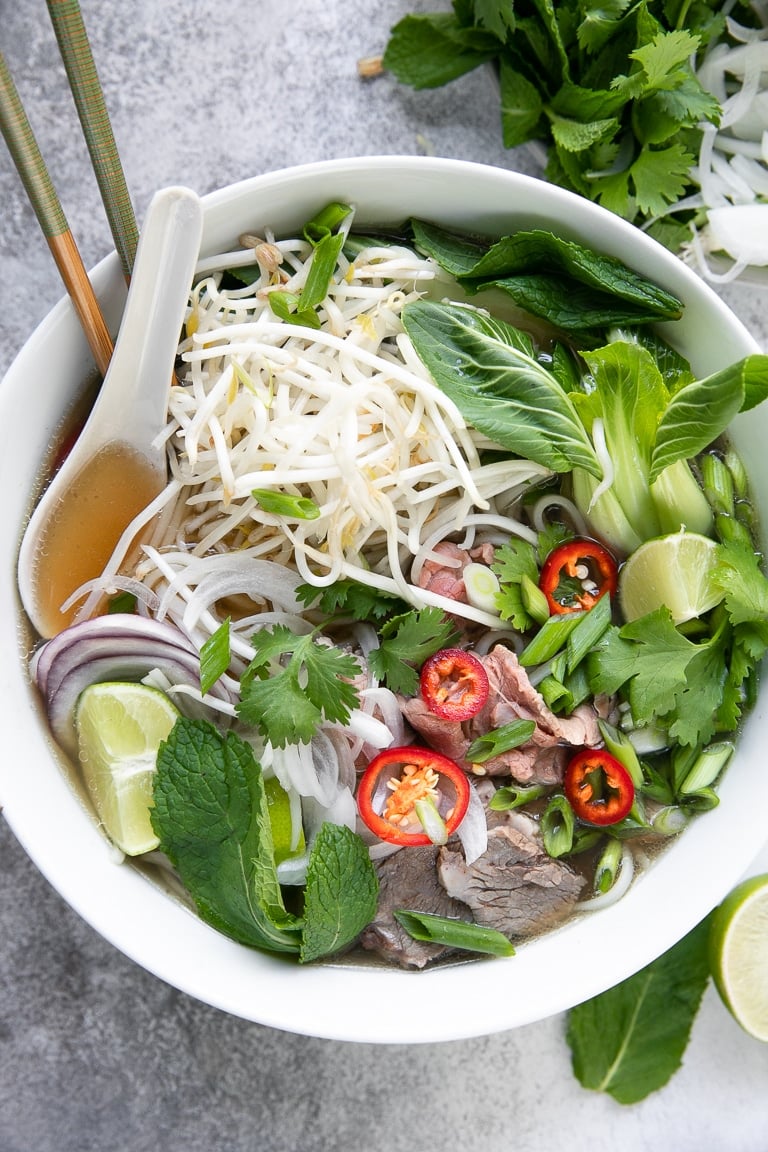
Table of Contents
About This Recipe
Pho (pronounced “fuh”) is a popular Vietnamese Noodle Soup and a recipe truly worth learning how to master. Filled with layers of aromatic and complex flavors, the key to any good pho recipe is the broth.
In this post, I will share two methods for making pho broth.
The first, more authentic version, is lengthy but completely worth the extra effort if you’re looking to duplicate the pho from your favorite Vietnamese restaurant. The method is nearly identical to making homemade bone broth and comes packed with tons of nutritional benefits. The recipe makes a lot of broth, so cut in half or freeze the leftovers for a rainy day.
The second, less authentic (translation: not at all authentic), version, is a fast and easy 20-minute broth inspired by my bok choy soup recipe. Perfect for last-minute cravings, this version lacks much of the nutritional benefits of the above but it’s there for you when you’re in a hurry.
If this is your first time trying Vietnamese noodle soup, I recommend trying the fast version to start. It includes several of the same spices, so you’ll get an idea for the overall taste and flavor.
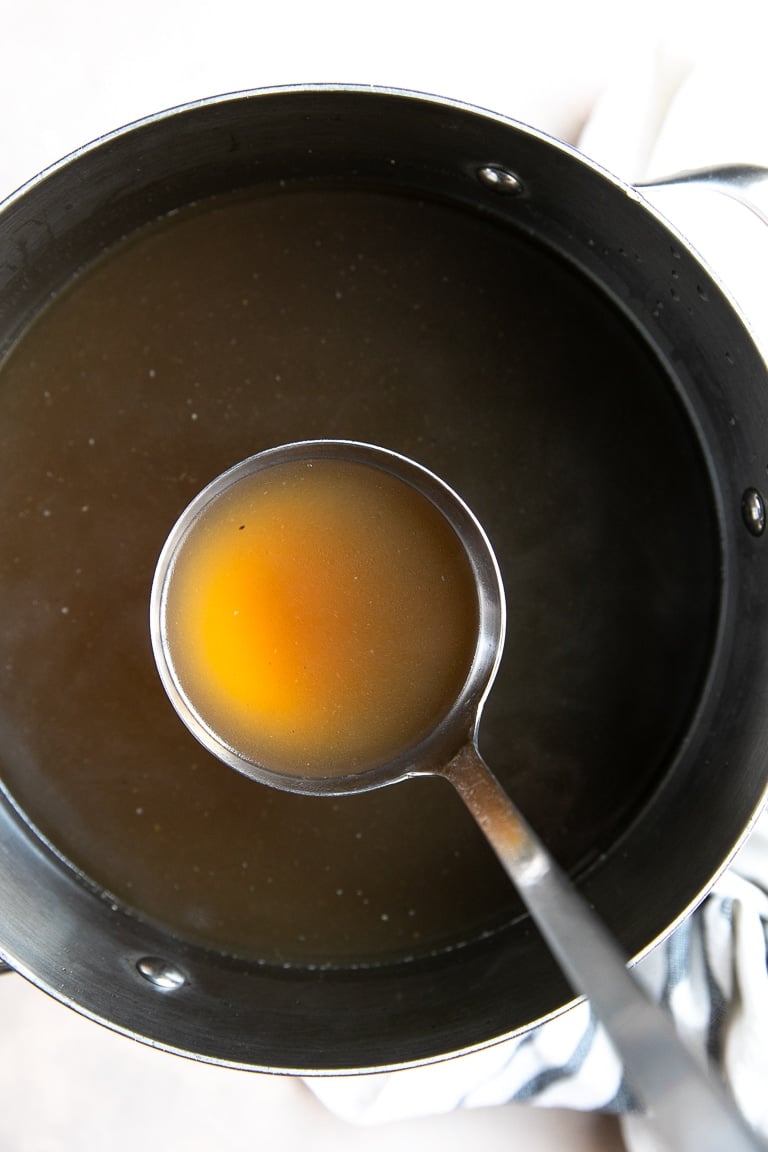
What is Pho?
Pho (Phở) originated in the early 20th century in northern Vietnam. It is a Vietnamese soup consisting of broth, bánh phở (rice noodles), simple herbs and vegetables, and meat. The type of meat typically found in Pho is usually either phở gà (chicken pho) or phở bò (beef pho).
You will find that different parts of Vietnam serve different styles with some regions offering a sweeter broth, different herbs, or wider noodles.
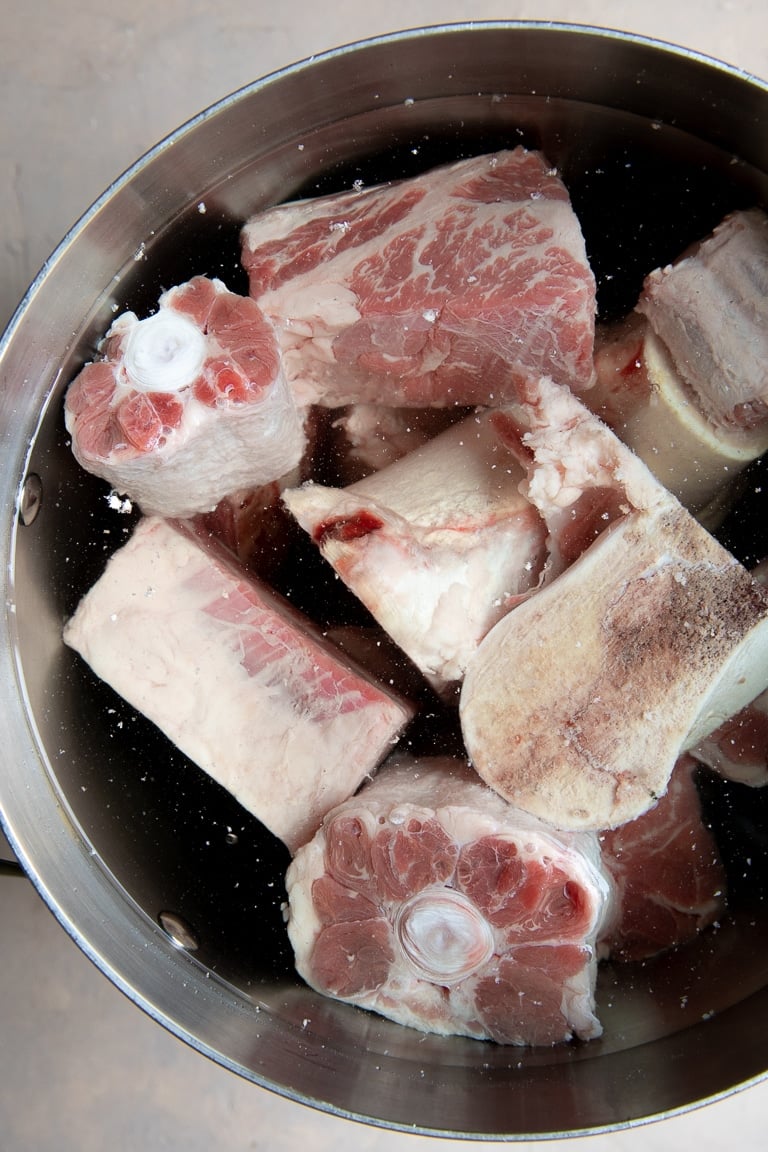
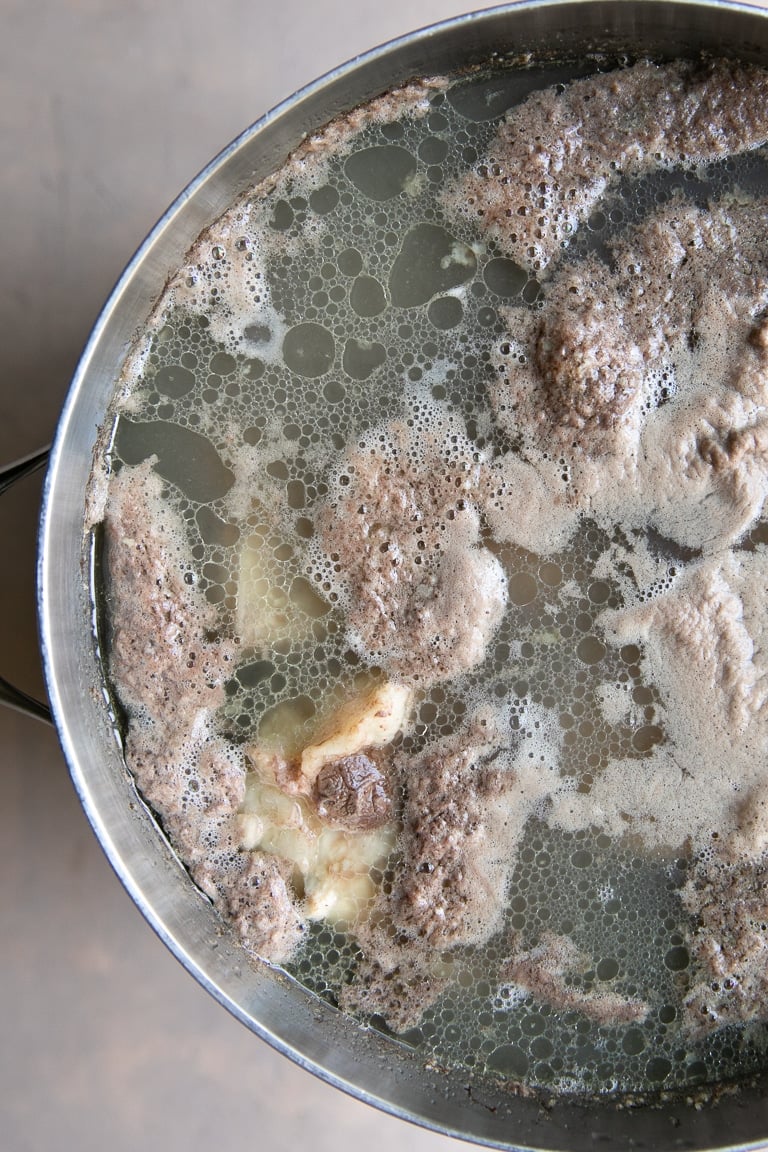
Pho Ingredients & Frequently Asked Questions
For this pho recipe, I chose to make phở bò, or beef pho. You can find most of the ingredients at your favorite grocery store, Asian supermarket, or online (like Amazon).
- Marrow bones and Meaty bones
- Thinly sliced raw meat
- Yellow onions
- Whole garlic
- Fresh ginger
- Whole spices: star anise, cloves, cinnamon sticks, black cardamom pods, fennel seeds, coriander seeds
- Salt
- Fish sauce
- Sugar
What bones should I use to make pho broth?
The best beef pho broth is made using several different types of beef bones. I like to add strictly marrow bones (no meat) and meaty bones (bones with meat on them. Try to incorporate a mix of knuckles, joints, feet, or marrow bones like leg and shin bones that have been cut into smaller pieces. For added flavor incorporate meaty bones like oxtail, shank, and short ribs. You can also toss in 2-3 pounds beef brisket or beef cheek, which adds amazing flavor and provides leftover meat for sandwiches and soups.
How can I slice my raw beef super thin?
The easiest way to thinly slice tender raw beef is to partially freeze it before slicing. Careful not to freeze it all the way, though! Otherwise, it will be impossible to slice through. It’s also helpful to have a recently sharpened knife.
Raw meat- what’s the best cut?
Boneless is easiest to slice. Flank steak, tri-tip steak, or brisket. Or, you can splurge (recommended!) and add beef tenderloin – so yummy!
Remember – you’re not cooking this meat before adding it to the soup. Instead, you will add to your bowl of noodles and pour your boiling broth directly over the top. The result is perfectly cooked medium-rare slices of meat.
Do you have to blanch the bones? The answer is no. However, I recommend, especially if you’re you’re making your broth from beef bones, that you do blanch them first. If you’re using chicken bones or chicken feet- blanching is less important, but beef bones really need this extra step, to remove impurities, coagulated protein, and blood which ultimately results in a cleaner, better tasting broth.
As far as nutrient loss due to blanching? The nutrient loss is too small to justify not blanching (in my opinion).
The spices are really important
If you’re wondering what sets pho broth apart from regular beef bone broth, it’s all the added spices and aromatics. I know that there’s a lot of them, but they’re each incredibly important. So, if you’re wondering if you can skip out on the spices and still have amazing broth, the answer is absolutely – but it won’t be Vietnamese pho soup broth, it will simply be bone broth.
Also, note that it’s a good idea to toast your spices in a dry pan or skillet before adding them to your simmering pot. This just helps intensify their flavors. Remember to pick up or order some cheesecloth (food grade) and kitchen twine to wrap them in.
What noodles are used in pho?
Available fresh and dried, these rice noodles typically come in small, medium, and large widths. Fresh Bahn Pho Kho is typically pretty hard to locate outside of specialty supermarkets, so you’ll probably find yourself with dried noodles. That’s ok- dried noodles are great. The best size for soup is either small or medium.
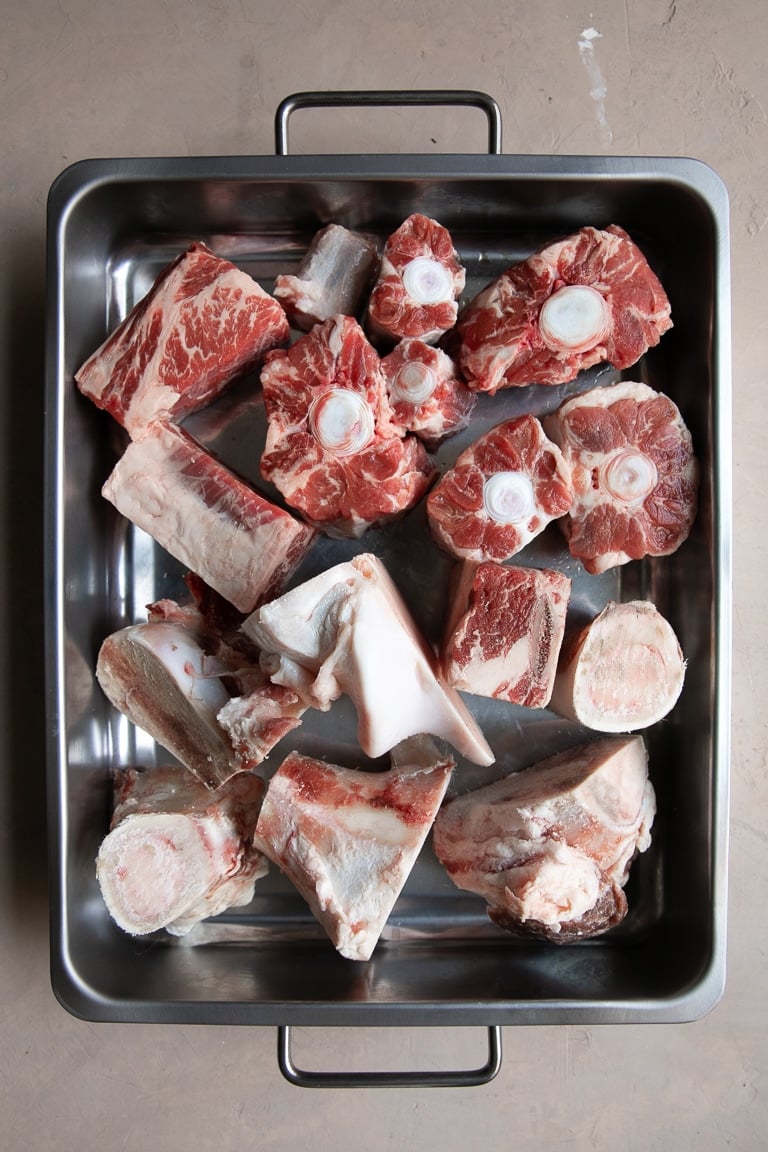
How to Make Pho
As I discussed above, you’ll want to get your hands on some rice noodles. These rice noodles are awesome as they don’t need to be boiled. Simply place in a pot of boiling water and allow them to rest for approximately 10 minutes before draining.
Do you have to use rice noodles? No, of course not. But, they’re highly recommended. Rice noodles are chewy, delicious, and made to go in Vietnamese noodle soups.
Can you boil the rice noodles directly in the broth? No. Well, I mean technically, yes. But, no. Please, boil or soak your noodles separately. Especially if you spent the hours and hours to make beautiful, clear, delicious bone broth. If you cook directly in your broth it will make your broth cloudy and your noodles will (likely) fall apart or turn soggy over time.
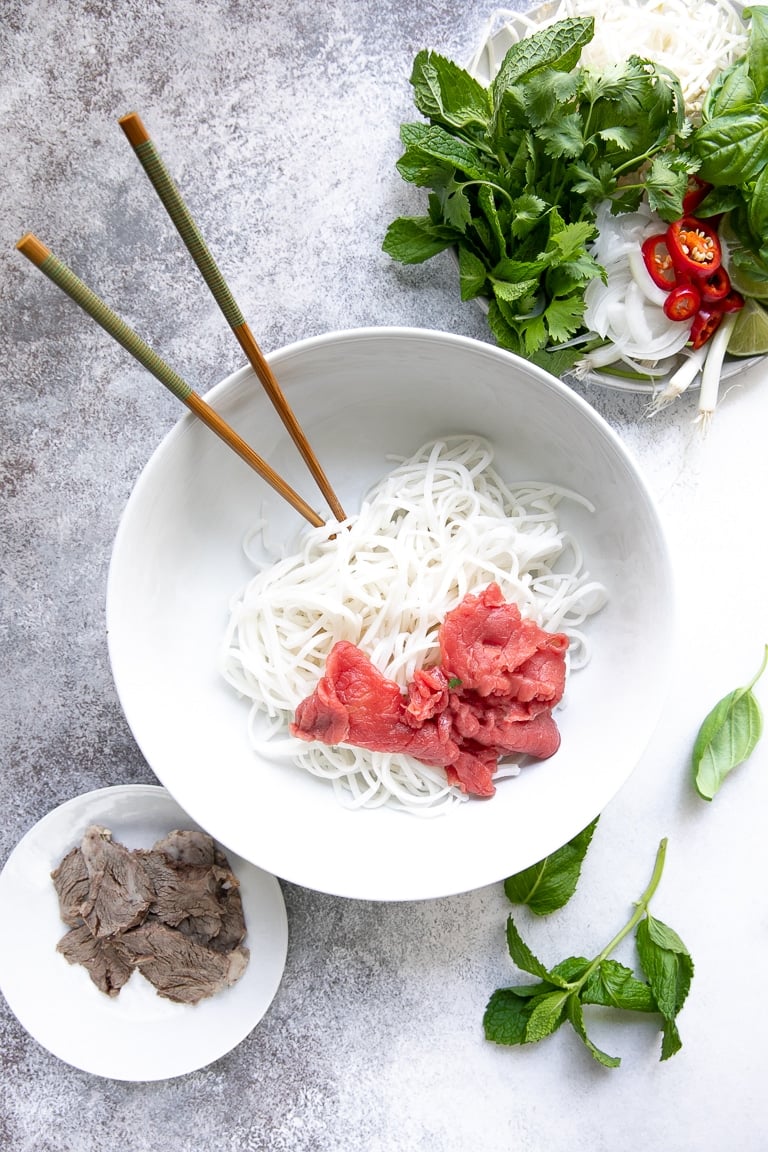
Assembling the Very Best Bowl of Pho
Like building the perfect sandwich, there is a right and a wrong way when constructing a bowl a pho.
The wrong way? Throw everything together. The right way? Throw it all together, in a very specific order.
- Pick a large enough bowl. YOU GUYS, Vietnamese noodle soup needs big bowls. Cereal bowls will not work here. Between the noodles and the broth and the veggies, bowls fill up fast.
- Rice noodles first. Add your pre-cooked noodles first. My husband loves a whole lot of noodles, whereas I love extra veggies. Fill your bowl appropriately.
- Raw meat next. Yes, you guys. RAW. Totally, completely uncooked (see above). Remember how I mentioned slicing your beef super (paper) thin? This is why. Don’t worry, assuming your broth is boiling hot and not just warm, your meat will get fully cooked.
- Add the broth. It doesn’t matter which broth (the fast or the slow method), this is the moment. Just make sure it’s super hot.
- Garnish like crazy. Add cooked beef from the bones you used to make the bone broth, add one sauce…or five. Guys, it’s up to you! Have fun!
Garnishes
Basically, all the things you want to pile on top of your soup. Think fresh, green, and healthy.
- Fresh mint
- Sprigs of Thai basil
- Fresh cilantro
- Green onions (scallions)
- Sliced white or red onion
- Fresh lime wedges
- Mung bean sprouts
- Sliced Thai red chiles
- Cabbage
- Bok choy
- Sliced Jalapeño
- Sriracha or other spicy chili sauce
- Hoisin sauce
- Fish sauce
You know, those things.
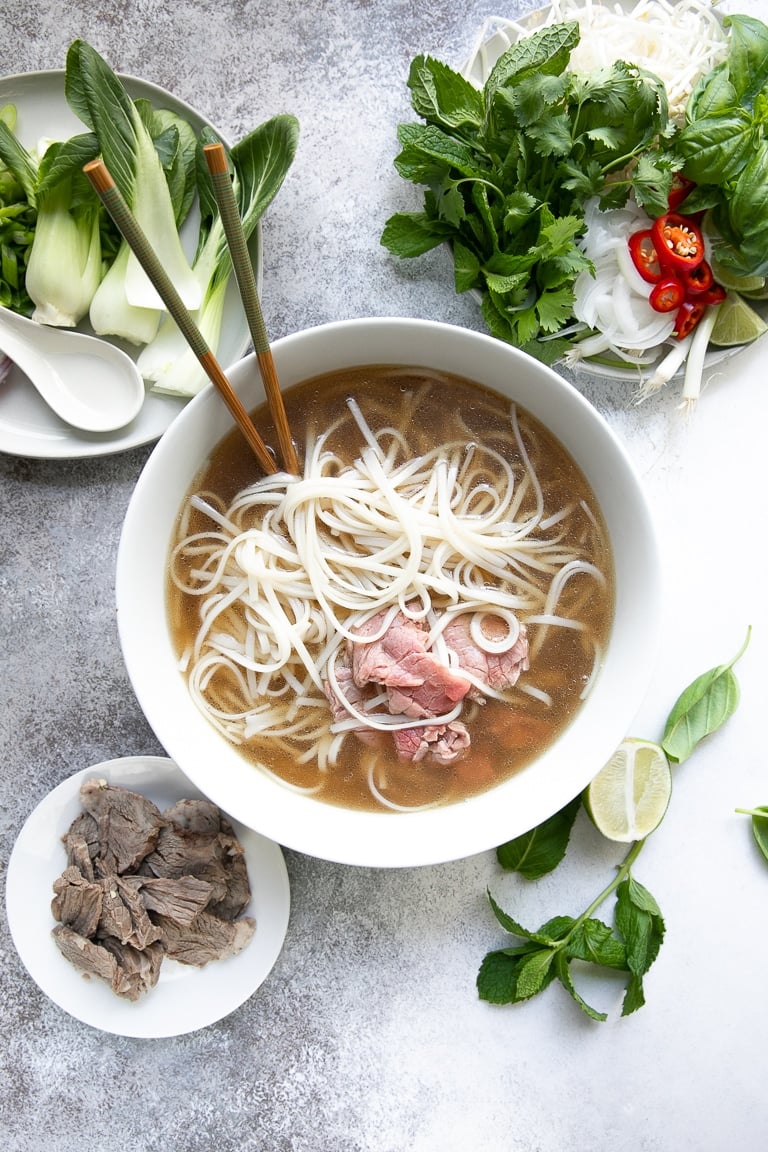
How to Store Leftover Pho Broth
Before storing your pho broth in the refrigerator or freezer you want to cool it down to room temperature. Ideally, you want to do this as quickly as possible to prevent any chance of contamination. The easiest way to do this is by adding a couple of handfuls of ice to the pot, covering, and waiting for the broth to cool. The ice helps expedite this process.
Or, as suggested by a reader, fill your sink or bathtub with a few inches of cold water. Place the pot in the cold water and allow the broth to cool to room temperature.
Store the leftover broth in a large stockpot, in mason jars, or in glass storage containers. If you plan to freeze your broth, transfer desired amounts to large ziplock bags with most of the air removed. Lay flat and allow at least 4-6 hours to freeze completely.
The leftover broth will stay fresh for up to 5 days in the refrigerator and 6 months in the freezer.
I do NOT recommend freezing anything other than the pho broth. That means, no noodles and no veggies. Only the broth.
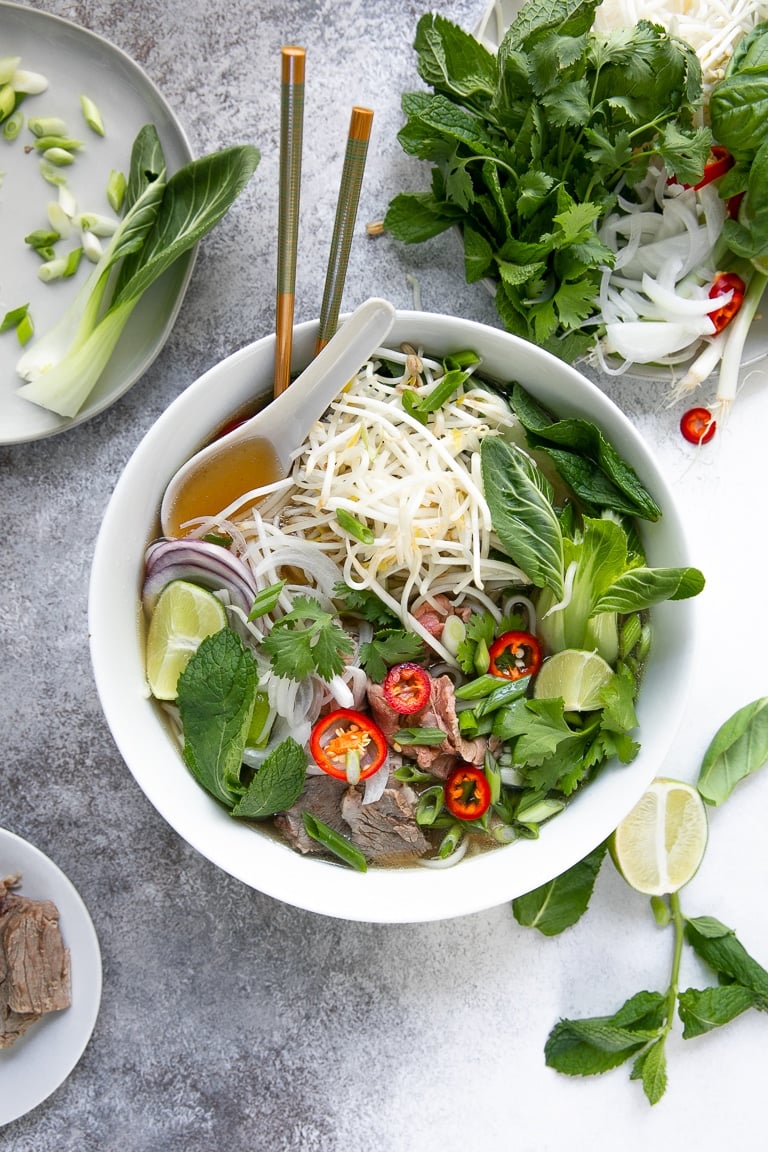
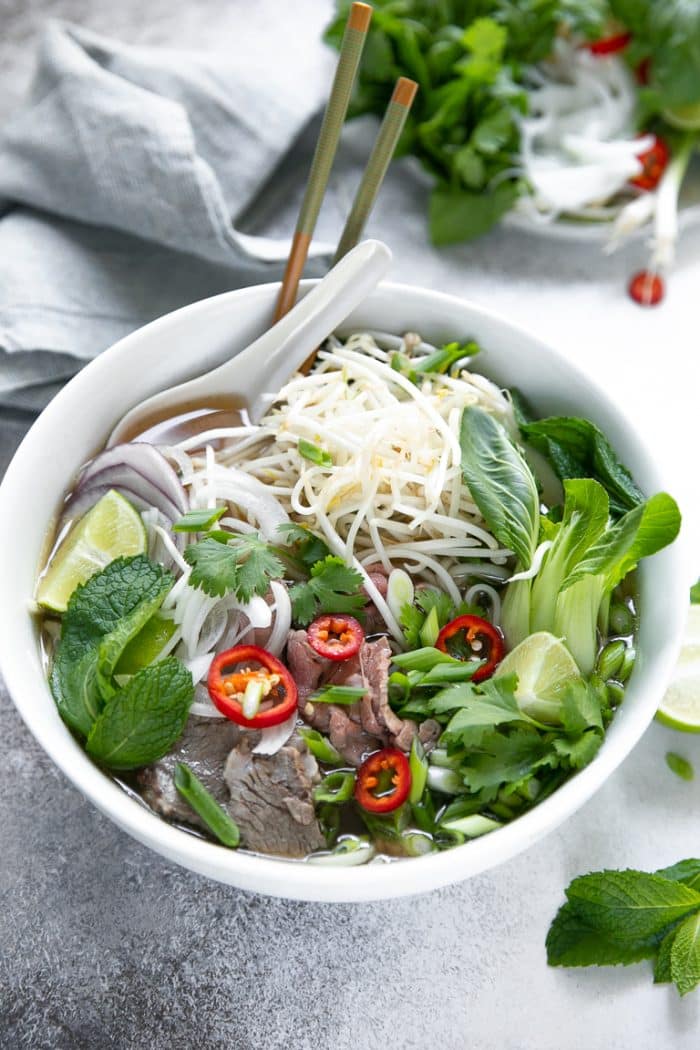
Pho Recipe
Ingredients
Authentic Pho Broth (8+ hours)
- 10 pounds beef bones, preferably a mix of marrow bones (femur bones) and bones with meat on them (oxtail, short ribs, and knuckle bones cut in half)
- 2 medium yellow onions, peel and quarter
- 2 whole heads garlic, halved crosswise
- 4 (2-inch pieces) ginger, sliced lengthwise
- 6 whole star anise
- 12 whole cloves
- 2 whole cinnamon sticks
- 2 black cardamom pods
- 2 tablespoon fennel seeds
- 2 tablespoon coriander seeds
- 2 tablespoon salt, (plus more to taste)
- ⅔ cup fish sauce, divided between the two pots
- 4 tablespoon sugar, divided between the two pots
Non-Authentic Pho Broth (20-30 minutes)
- 1 tablespoon olive oil
- 3 shallots, diced
- 1 bunch green onions, chopped, green and white parts divided
- 4 cloves garlic, minced
- 2 tablespoon fresh ginger, minced
- 6 cups low-sodium chicken broth, or low sodium beef broth or water
- 2 whole star anise
- 1 tablespoon soy sauce
- 1 tablespoon fish sauce
Assembly
- 1 pound flat rice noodles, dried or fresh
- 1 pound beef, flank steak, chuck roast, brisket, sirloin (sliced thin against the grain)
- sliced red or white onions
- fresh cilantro, chopped
For the Table
- fresh mint, Thai basil
- mung bean sprouts
- green onions, (scallions)
- sliced jalapeño
- lime wedges
- thinly sliced red chilis
- hoisin sauce
- fish sauce
- chili sauce
- bok choy
Instructions
Authentic Pho Broth (8+ hours)
- Blanch the bones. This step is SO IMPORTANT. If you want a clear, beautiful pho broth, blanch your bones. Do this by dividing the bones between two large pots or stockpots. Cover with cold water. Bring to a boil over high heat and simmer for 15-20 minutes. Drain and rinse the bones with water.
- Roast the bones and the vegetables (optional). Preheat the oven to 450 degrees F. Transfer the bones, onion, garlic, and ginger to the roasting pans or rimmed baking sheets (you'll probably need two). Don’t pile them all on top of each other. Roast for 30 minutes before gently tossing the bones, and roasting for an additional 15-30 minutes more (for a total of 45-60 minutes).
- Toast the spices. As the bones are roasting, add all of your spices (the star anise, cinnamon, cloves, cardamom pods, coriander seeds, and fennel seeds) to a large, dry skillet over low heat. Toast the spices, stirring often to prevent burning, until fragrant, approximately 5 minutes. Divide the spices in half. Cut cheesecloth into two small square pieces (approximately 5-inches by 5-inches) each. Transfer the divided spices to the center of each square. Gather at the top and secure with kitchen twine.
- Transfer the roasted bones and veggies back to the stockpots. Making sure to wash the pots after the bones were blanched and drained. Transfer and divide the roasted bones, onion, garlic, and ginger back to the stockpots. Scrape up any remaining bits and juices left in the roasting pan using a metal spatula and a little water, if needed. Add to the pot with the bones (don’t worry, all those brown bits are FLAVOR!).
- Bring to a boil. With the bones, spice sachets (one per pot), onion, garlic, and ginger divided between the two pots, fill each pot with approximately 12 cups water (or until bones are fully submerged), 1/3 cup fish sauce and 2 tablespoons of sugar. Bring to a boil.
- Simmer the bones. Immediately reduce heat to low and simmer, with the lid slightly ajar, skimming any foam or excess fat, occasionally (if you blanched your bones, you shouldn’t see much foam). Simmer for at least 6-12 hours, ideally 24 hours (do not leave the stove running overnight. Simply cool and store in the refrigerator and continue to simmer the next day). Add more water if needed to make sure the bones stay submerged.
- Strain the broth. Once the bones have simmered and your hot broth is ready, strain it through a fine-mesh strainer or colander into a clean pot. This separates the pretty, clear broth from the bones and spices.
- Season to taste. Add additional salt (you'll probably need a little), soy sauce, fish sauce, sugar or rock sugar (found at Asian markets), to taste. Set aside the broth to cool (if you're not using right away) and reserve the bones.
- Don’t forget about the meat. I can almost guarantee that there is a TON of delicious meat waiting to be picked from the bones. Don’t let it go to waste! Discard the meat-free bones, herbs, and other bits that were used to make the broth, but save the meat and add to sandwiches, wraps, salads, or back to your broth.
- Skim the fat from the top (optional). Add a couple of handfuls of ice to your broth to expedite cooling and cover your pot with a lid. Transfer the broth to the refrigerator and allow the broth to cool fully (this will take upwards of 6 hours or overnight). The result will be a hard, thick layer of fat on the top and a bottom layer that is your pho broth (which should look like gelatinous brown jello). If desired use a fork to scoop off the top layer of fat.
Non-Authentic Pho Broth (20-30 minutes)
- Cook the mirepoix. To a medium stockpot over medium heat, add the olive oil and shallots. Cook the shallots for approximately 5 minutes, stirring often. Add the white parts of a few green onions, the minced garlic, and ginger. Stir well to combine and cook for 1-2 more minutes.
- Add pre-made broth or stock. Add your favorite store-bought broth or stock to the pot and bring to a simmer.
- Add some flavor. Add 1-2 whole star anise, soy sauce, and fish sauce to the broth. Cover. Simmer for 15-20 minutes.
- Remove the star anise. Try not to forget this part.
- Season to taste. When it comes to Pho, you do you. Add more salt, more sugar, more fish sauce, etc.
Assembly
- Slice your meat. Thinly slice your meat. If you’re having trouble, place it in the freezer for 10 minutes which will make it easier to slice.
- Noodles first. Grab a large bowl and divide the pre-cooked noodles between bowls.
- Add the raw meat. Yes, you guys. RAW. Add the meat directly on top of the rice noodles. Don’t worry, assuming your broth is boiling hot and not just warm, your meat will get fully cooked.
- Add the broth. It doesn’t matter which broth (the fast or the slow method), this is the moment. Just make sure it’s super hot and ladle directly over the meat.
- Garnish like crazy. Add some extra cooked beef from the bones you used to make the bone broth, add one sauce…or five. Guys, it’s up to you! Have fun!
Notes
- This recipe will require two (8+ quart) stockpots and two roasting pans or rimmed baking sheets. You can easily cut the recipe in half. However, pho soup freezes well and takes so much effort, why not, right? You will also need 1-2 large Roasting Pans or rimmed baking sheets.
- Servings amounts. Authentic Pho Broth (approximately 8 large bowls or 24 cups of broth). Non-Authentic Pho Broth (approximately 2 bowls of Pho).
- Why chicken broth for quick pho?
Most store-bought beef broths are dark and stew-like, which can mask pho’s delicate spice profile. A good chicken broth is cleaner, so the aromatics come through; fish sauce and the beef itself provide plenty of beef flavor. Use homemade/light beef broth or a 50/50 mix if you prefer a stronger beef note.
Nutrition
Nutrition information is automatically calculated, so should only be used as an approximation.
More Soup Recipes,
If you’re craving something warm, cozy, and satisfying, there’s nothing better than a homemade bowl of soup. My Homemade Chicken Soup Recipe is a classic, hearty, nourishing, and perfect soup for chilly days or when you’re feeling under the weather. Spice things up with this quick Kimchi Ramen Noodle Soup ready in just 30 minutes, or for something light and soothing, Miso Soup and Egg Drop Soup are both easy to make. If you’re in the mood for thick and chewy noodles, you’ll love my Udon Noodle Soup with Bok Choy.
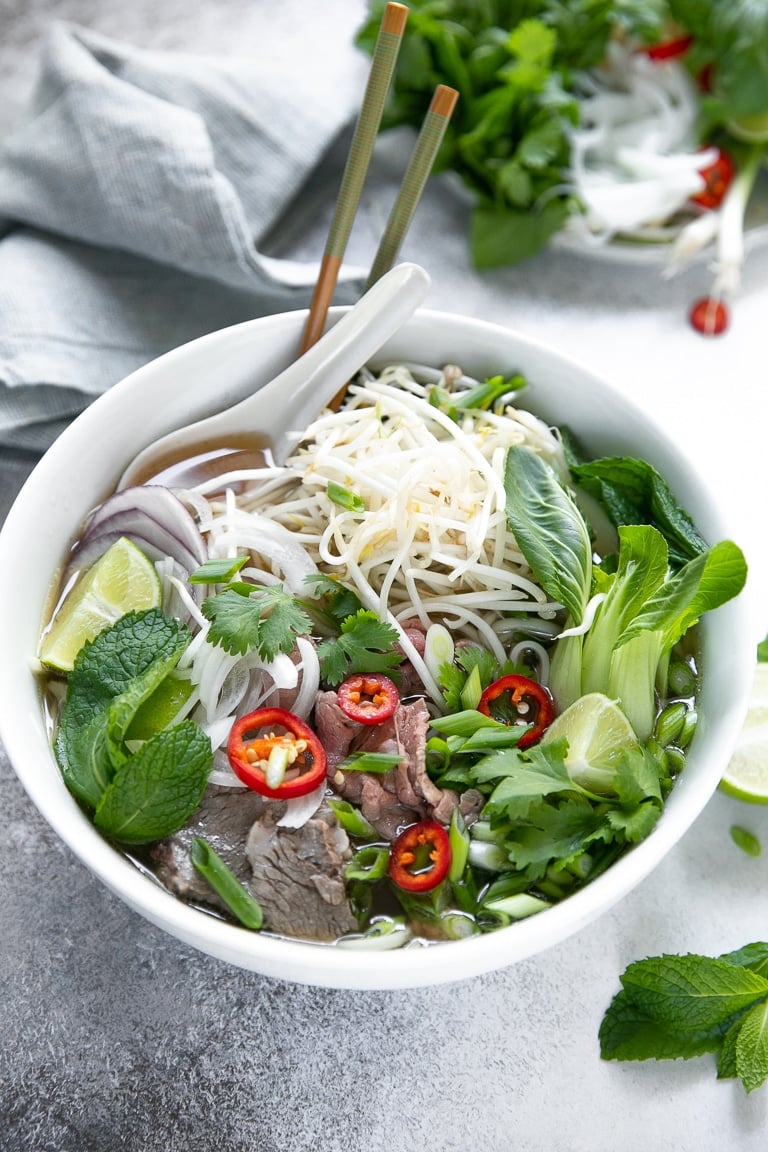
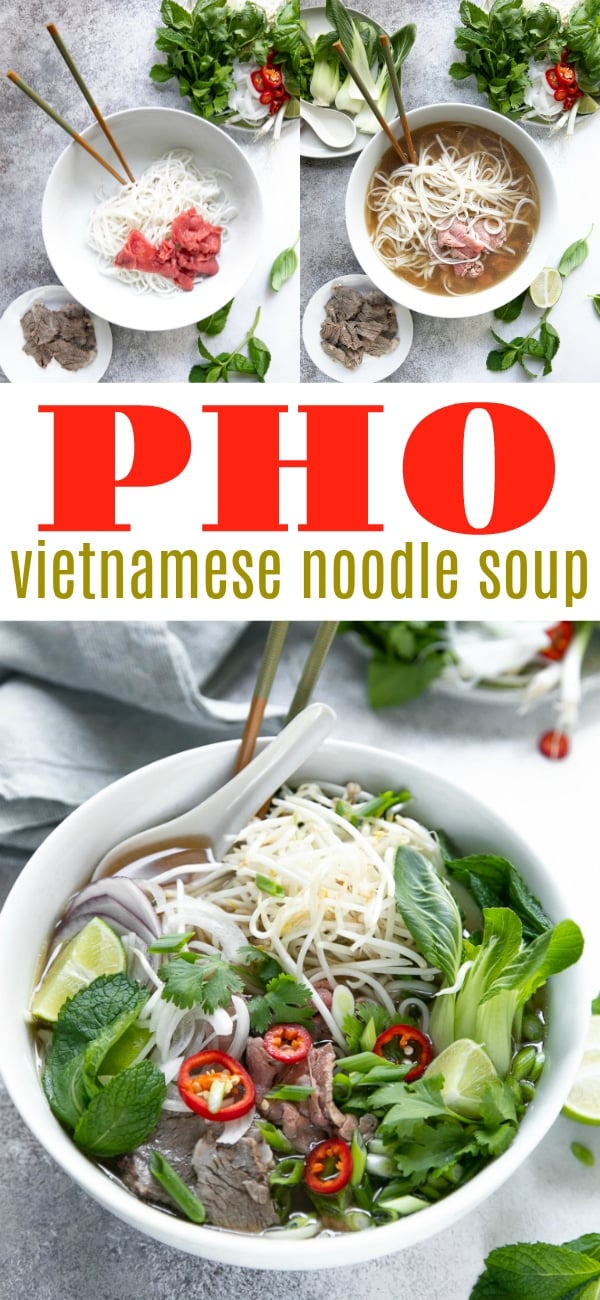
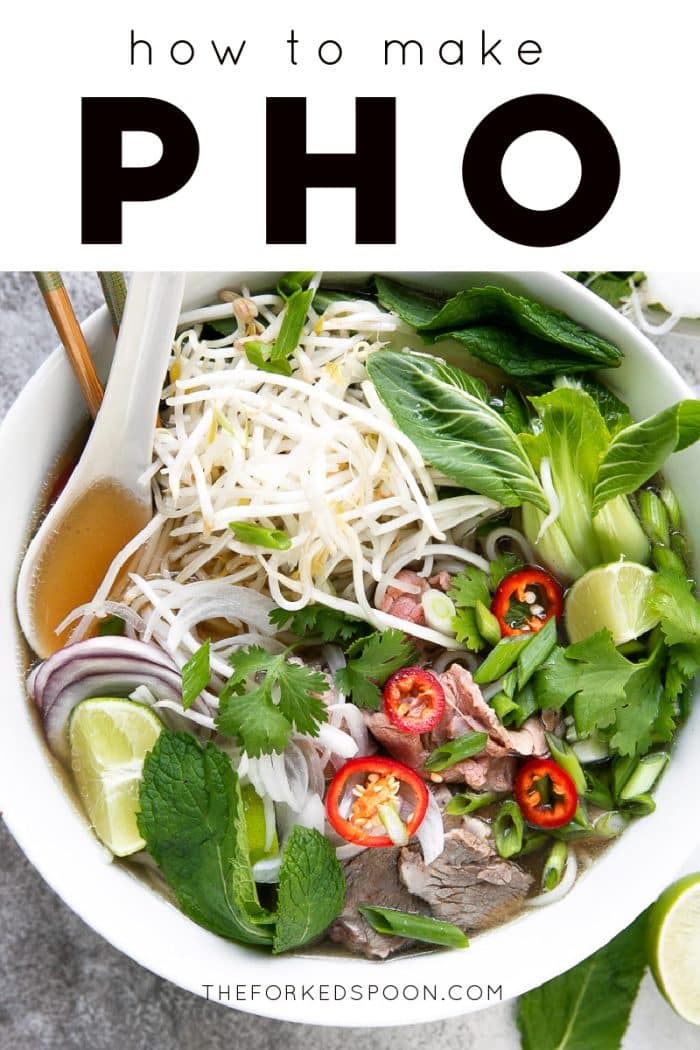
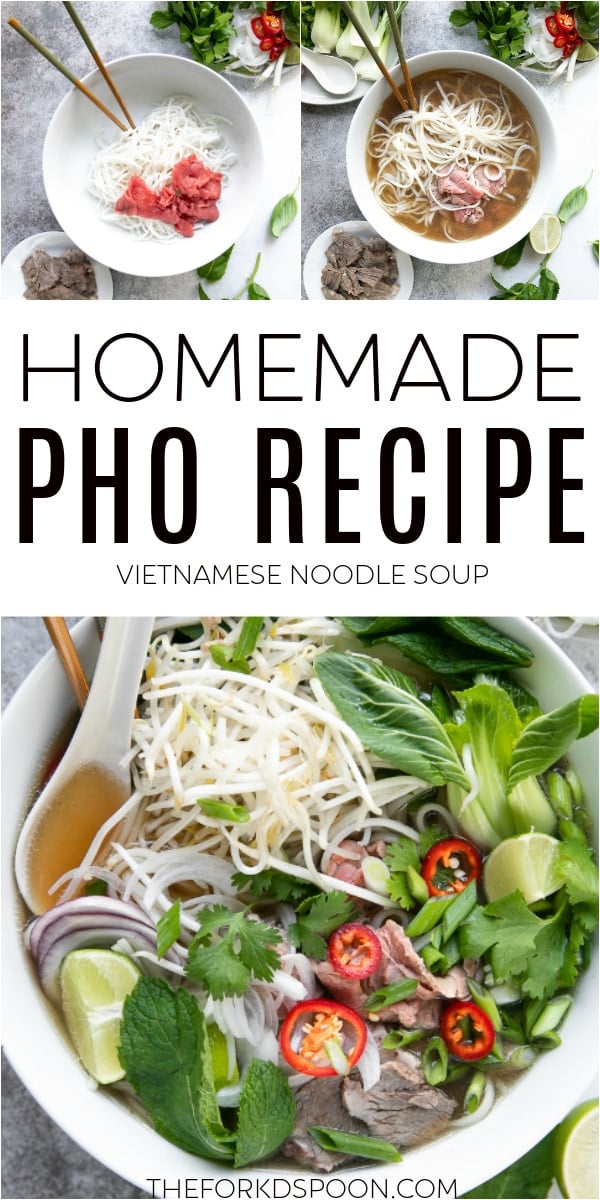
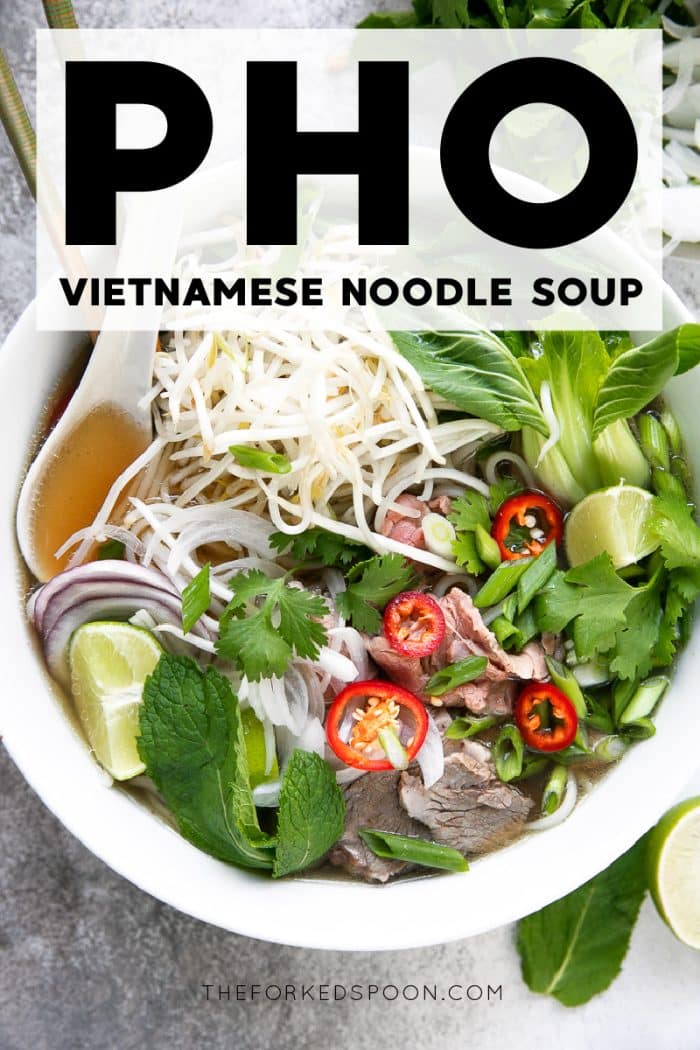


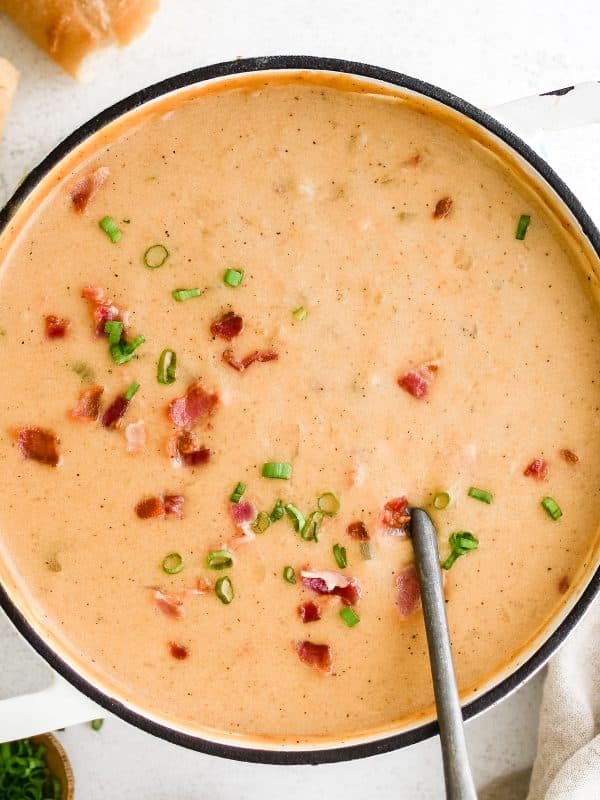










I have access to rice noodles but can also make homemade ramen. Thoughts??
For classic pho, stick with flat rice noodles (bánh phở); cook them separately and give a quick rinse before serving so the broth stays clear. Homemade ramen will work in a pinch, but the alkaline wheat changes the flavor and chew to more ramen style, so cook just shy of done and add right before serving.